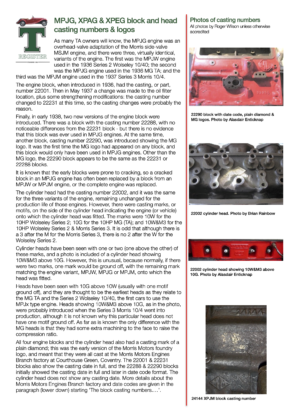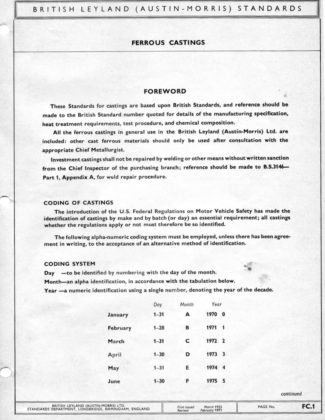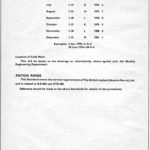T Type chassis and engine identification
Chassis
The chassis number is the key data for identifying your car. On all T-types it is stamped on the near-side dumb-iron or chassis extension. This number should agree with the chassis number (or car number) stamped on the plate(s) riveted to the battery/tool box or bulkhead under the bonnet of the car. For models TA/TB/TC there is no problem because there are no prefixes used; the chassis numbers run from TA 0253-3255, TB 0252-0630 and TC 0252-10251. Some historians might dispute this, but it seems that the prototype TAs were numbered 0251 and 0252, while the prototype TB and TC were numbered 0251 and were not counted as production cars.
For the TD there were two types; plain TD and TD/C, the ‘competition’ version with bigger valves and carbs and stiffer front suspension. This latter is also called the Mark II and hence often confused with the code TD2, which formed part of the engine codes of cars produced after about chassis number 10000 in mid July 1951, and signifying a larger clutch. The TD chassis numbers are from 0251 to 29915. TDs also had extra codes for export cars, EXR and EXL for RHD and LHD respectively. For cars exported to North America, the code used for early TDs was EXLU and from May 1951 the code for these cars started to be changed to EXL/NA, later EXLNA, although a mixture of EXLU and EXL/NA continued to be used until the end of May/early June 1951.
In the case of the TF, after two prototypes, Abingdon started to use the company-wide Nuffield numbering system starting at 501 (the BMC numbering system was not introduced within MG until 1959 with the introduction of the MGA 1600). After 6200 TF 1250s and 3400 TF 1500s, the last TF was numbered 10100. The TF prefixes of the Nuffield numbering system that make up the Car Number on the identification plate are easily decoded thus:
Letters:
HD stands for M.G. 2-seater in the Nuffield scheme of things. A = Black, B = Light Grey, C = Dark Red, E = Mid Green, P = Ivory.
First Digit:
1 = U.K. RHD, 2 = Export RHD, 3 = Export LHD., 4 = North America LHD.
Second Digit:
3 = Cellulose, 5 = Primer, 6 = Cellulose Body, Synthetic Wings.
The chassis stamping was TF plus chassis number (the ‘TF number’) whereas on the identification plate the car number was used. Thus, for example, HDE 23/10081 is a RHD. export model (it went to South Africa) painted in green cellulose (it still is) and was one of the last TFs made (in March 1955).
Other letters and digits have been seen on assembled TF CKD cars and usually conform to the Morris Motors standard. There is an explanation of the Morris standard on another page.
Engine
The engine should have an octagonal, circular or square plate, with a centre brass disc, riveted to the left-hand side of the flywheel housing for the TA, TB & TC, or on a shallow plinth on the forward right-hand side of the main block for some late TCs, then the Y, YT, TD, YB & TF. The engine number will be stamped on the plate, and the centre disc will show the engine type as described below. For the Y, YT, TD, YB & TF, the engine number will also be stamped on the shallow plinth just above the plate.
The full engine number consisted of a prefix as shown below indicating the engine type, which was related to the model of car, followed by the engine number, and the full engine number was normally stamped on the car identity plate on the bulkhead.
- • TA were prefixed MPJG and were unique to that model
- • TB, TC, TD, TF 1250 were prefixed XPAG
- • TF 1500 had an XPEG prefix
Specific identity of the model to which the engine was fitted is given by further numbers and letters as follows:
- • TB and TC engines, oval water holes and a 7¼” clutch, were prefixed XPAG/…..
- • TD and TD Mark II engines, oval water holes and a 7¼” clutch, were prefixed XPAG/TD/…. (Y engines XPAG/SC/…., YT LHD engines XPAG/TL/…., YT RHD engines XPAG/TR/….)
- • TD and TD Mark II engines, oval water holes and an 8″ clutch, were prefixed XPAG/TD2/…. (Y and YB engines XPAG/SC2/….)
- • TD Mark II engines, round water holes and an 8″ clutch, were prefixed XPAG/TD3/…..
- • TD engines, round water holes and an 8″ clutch, retained the prefix XPAG/TD2/…. (YB engines retained the prefix XPAG/SC2/….)
- • TF 1250cc engines, round water holes and an 8″ clutch, were prefixed XPAG/TF/…..
- • TF 1500cc engines, round water holes and an 8″ clutch, were prefixed XPEG…..
For the export LHD TD, Y and YB, the engine prefix had an extra LHX in front of the number;
eg. XPAG/TD/LHX…., but this normally only appeared on the bulkhead plate.
A large number of cars with XPAG or XPEG engines have had Morris Motors or BMC (Gold Seal) replacement engines fitted. These usually did not have an XPAG number on an octagonal plate, but instead a letter prefix (A, B, C, E, G & RS have been seen) followed by a larger than usual number (E99794 has been seen) on a square ‘replacement engine’ plate. With replacement engines, the original number of that engine can sometimes be seen just above or covered by the square plate, stamped on the block. Be prepared to find, however, that the engine in your T type might have started life in a Y type, or vice versa!
More on casting numbers and block markings
Roger Wilson has also written a researched and more extensive explanation of changes made to the MPJG, XPAG and XPEG engines which relate to the head and block casting numbers.
This pdf file has lots of photographs of existing blocks and heads together with a link to an album of photos showing you what to look for, including the casting marks about which we now have some new information, including the W-in-a-diamond mark found on later XPAG and XPEG blocks.
Our thanks are due to David Braun, Chris Collingham, Bob Douglas, Alasdair Enticknap, Barrie Jones, Graeme Louk, Brian Rainbow, Bill Silcock, Mike Stone, Mark Tullett, Arthur Vowden and Barry Woolford for contributing photos.
There is also a full album of photos of casting marks with a description of each available.
Date coding of castings
XPAG and XPEG blocks weren’t the only engine blocks cast at the Wellingborough Ironworks and lots of components for Nuffield tractors were made there too.
We also now have some new information, courtesy of the Nuffield and Leyland Tractor Club and John their historian in the form of an Austin Morris standard for casting the date coding on blocks and heads, and although the document is from 1971, it is a revision of an original 1953 standard.
It’s our first real piece of evidence of how to decipher the date coding found near the dipstick on blocks, and on heads to the rear on the same side as the casting number.
Because of this document, we now have a reasonable working table to decode the casting dates of blocks, although it is not perfect: we have seen blocks with more letters or numbers than match our table and these are being investigated.
This information will be updated as soon as we have more information, but in the meantime if you can send us a picture of the coding near the dipstick on your engine we’d be most grateful: we need more information!



